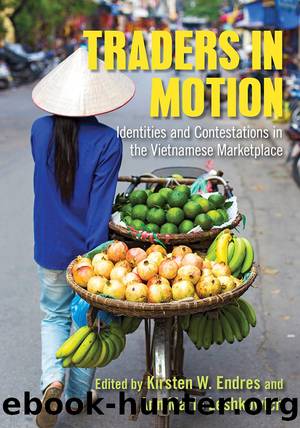Traders in Motion by Kirsten W. Endres Ann Marie Leshkowich

Author:Kirsten W. Endres, Ann Marie Leshkowich [Kirsten W. Endres, Ann Marie Leshkowich]
Language: eng
Format: epub
Tags: Nonfiction, History, Asian, Southeast Asia, Social & Cultural Studies, Social Science, Anthropology
ISBN: 9781501721359
Publisher: Cornell University Press
Published: 2018-06-15T04:00:00+00:00
Dynamics of Petty Trade under the Urbanization and Modernization Process
Mobile Vendors
Although petty trade had always been a source of additional income for peasants in the Red River Delta, this practice was limited during the subsidized economic period. Only since Äá»i má»i have mobile street vendors become an integral part of everyday urban life in Hanoi (Barthelmes 2014). Research on seasonal migration has shown that rural migrants began to move to Hanoi during the early 1990s (Nguyen Van Chinh 2013). Given their proximity to Hanoi, Lụa villagers have practiced their petty trade in Hanoi since the 1980s. It is not difficult to find elderly women in the village who have been employed in petty trade for thirty years in Hanoi, selling such items as vegetables, fruit, or recycling materials. Beginning in the 1990s, the practice of street vending also became popular in Lụa village. There was a particular movement in the village at that time where many young and middle-aged women, and some men, carried vegetables and fruit on two big baskets hung on their bikes to sell at the market and on the streets of Hà Äông town and Hanoi.
During the 1990s, mobile vendors of Lụa village were present at most markets and on main roads of Hà Äông town, Thanh Xuân district, and Äá»ng Äa district. In the late afternoon, it was common to encounter many long lines of bicycles with two big baskets of vegetables and fruits along main roads. A forty-year-old woman, Mrs. Duyên, recalled her experience: âAt the time when we were growing up, we didnât go to high school so did not know what to do except go to work at the market. There was a kind of âarmy of two basketsâ [Äá»i quân hai sá»t] in the village. It was crowded and cheerful, as we often hung around in groups with each other the whole day surrounding markets, offices, and on the pavement. I met my husband when we both went to the market.â
The number of practicing street vendors in Lụa village began to decline only in the early 2000s. The period from 2008 to 2009 was a time of restrictions for mobile vendors on many streets because of several official regulations. In reality this activity had already been curtailed through various policies put in place by the city intended to promote civilized trading streets, urban order, or sidewalk order.9 In other words, the new regulation was just an upgrade of the general policy Hanoi city had implemented previously in order to build a prosperous, beautiful, and civilized capital (Kiá»u Minh 2008). Our interviews show that street vendors were dismissed when practicing their work in the late 1990s, especially in the central areas. However, it is only since 2003 that they did not dare to cross the Ngã TÆ° Sá» roundabout with their bicycles and large baskets, as that was considered the limit of the inner urban area where mobile vendors with bulky goods are strictly forbidden. Since then, street vendors in Lụa village have withdrawn to Thanh Xuân and Hà Äông districtâtwo newly created urban districts of Hanoi.
Download
This site does not store any files on its server. We only index and link to content provided by other sites. Please contact the content providers to delete copyright contents if any and email us, we'll remove relevant links or contents immediately.
Life 3.0: Being Human in the Age of Artificial Intelligence by Tegmark Max(5198)
The Sports Rules Book by Human Kinetics(4081)
The Age of Surveillance Capitalism by Shoshana Zuboff(3999)
ACT Math For Dummies by Zegarelli Mark(3858)
Blood, Sweat, and Pixels by Jason Schreier(3500)
Unlabel: Selling You Without Selling Out by Marc Ecko(3476)
Hidden Persuasion: 33 psychological influence techniques in advertising by Marc Andrews & Matthijs van Leeuwen & Rick van Baaren(3305)
Urban Outlaw by Magnus Walker(3250)
The Pixar Touch by David A. Price(3225)
Bad Pharma by Ben Goldacre(3106)
Project Animal Farm: An Accidental Journey into the Secret World of Farming and the Truth About Our Food by Sonia Faruqi(3027)
Brotopia by Emily Chang(2902)
Kitchen confidential by Anthony Bourdain(2837)
Slugfest by Reed Tucker(2809)
The Content Trap by Bharat Anand(2784)
The Airbnb Story by Leigh Gallagher(2711)
Coffee for One by KJ Fallon(2433)
Smuggler's Cove: Exotic Cocktails, Rum, and the Cult of Tiki by Martin Cate & Rebecca Cate(2343)
Beer is proof God loves us by Charles W. Bamforth(2255)
